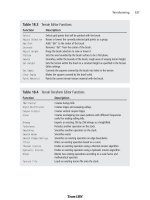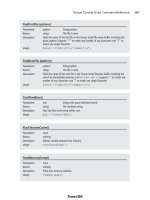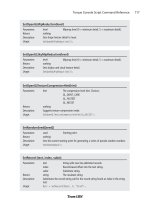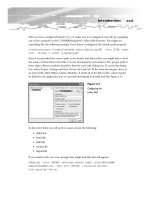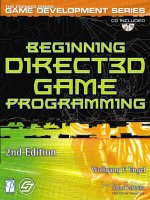torque 3d game development cookbook
Bạn đang xem bản rút gọn của tài liệu. Xem và tải ngay bản đầy đủ của tài liệu tại đây (4.5 MB, 381 trang )
www.it-ebooks.info
Torque 3D Game
Development
Cookbook
Over 80 practical recipes and hidden gems for getting
the most out of the Torque 3D game engine
David Wyand
BIRMINGHAM - MUMBAI
www.it-ebooks.info
Torque 3D Game Development Cookbook
Copyright © 2013 Packt Publishing
All rights reserved. No part of this book may be reproduced, stored in a retrieval system, or
transmitted in any form or by any means, without the prior written permission of the publisher,
except in the case of brief quotations embedded in critical articles or reviews.
Every effort has been made in the preparation of this book to ensure the accuracy of the
information presented. However, the information contained in this book is sold without
warranty, either express or implied. Neither the author nor Packt Publishing, and its dealers
and distributors will be held liable for any damages caused or alleged to be caused directly or
indirectly by this book.
Packt Publishing has endeavored to provide trademark information about all of the companies
and products mentioned in this book by the appropriate use of capitals. However, Packt
Publishing cannot guarantee the accuracy of this information.
First published: January 2013
Production Reference: 1180113
Published by Packt Publishing Ltd.
Livery Place
35 Livery Street
Birmingham B3 2PB, UK.
ISBN 978-1-84969-354-7
www.packtpub.com
Cover Image by Valentina D'silva
www.it-ebooks.info
Credits
Author
David Wyand
Reviewers
Logan Foster
Ahmad Iftikhar
Konrad Kiss
Chip Lambert
Acquisition Editor
Kartikey Pandey
Lead Technical Editor
Arun Nadar
Technical Editors
Prasanna Joglekar
Merin Jose
Dominic Pereira
Copy Editor
Ruta Waghmare
Project Coordinator
Anurag Banerjee
Proofreaders
Clyde Jenkins
Dirk Manuel
Indexer
Monica Ajmera Mehta
Graphics
Valentina D'silva
Production Coordinator
Pooja Chiplunkar
Cover Work
Pooja Chiplunkar
www.it-ebooks.info
About the Author
David Wyand grew up in Toronto, Canada, and graduated in Chemical Engineering from the
University of Toronto in 1994. Following graduation, he went to run the network management
system at a major telecommunications company; did freelance 2D compositing and 3D
animation work for the Toronto entertainment industry; and started his own consulting rm to
set up network management systems at various telecommunications and power companies in
Canada and the U.S. He then left that behind to work in the video game industry.
Starting with the successful 2005 launch of a tool for game artists to visualize their work in
real time, he moved on to game engine development. In 2006, he joined GarageGames as a
full-time contractor and has been working with them ever since. During this time he has had
his hands in nearly every game engine the company has released. Today he is the Head of
Torque 3D Development at GarageGames.
In 2009 he started Gnometech Inc. (
) to begin
developing his own commercial games. In 2010 he released Greenwood Faire, a web-based
3D world in a medieval setting. Since then he has created other online 3D worlds under the
Zworldo.com banner, and is looking to the future of virtual reality and unique input devices.
Big thanks to Julie, Matthew, Malcolm, and Melanie for their love and
support. Especially Julie, who took the kids away many a day so I could
write. I also want to thank my mom and dad for all the usual reasons.
www.it-ebooks.info
About the Reviewers
Logan Foster is the Art Director for Fluik Entertainment Inc., a mobile game development
studio based in Edmonton, Alberta.
As a 13-year veteran of 3D and 2D art development and production design and development
for games and digital media, he has contributed to over a dozen original IP and contract PC/
Mac, console, mobile, social, serious, and web-based games during his career.
Outside of his normal work duties, he also contributes as a private beta tester for Autodesk,
has spoken at several independent game development festivals on the topic of art production
for games, and in 2009 helped co-found and continues to help run GameCamp Edmonton,
an industry organization whose goal is to help further advocate and network the game
development industry in Alberta.
I would like to thank my wife Erin and kids Nathan and Seraphina for putting
up with all the long hours and craziness that comes with working in the
game industry.
Ahmad Iftikhar, 25, is the CEO of a cutting edge design and development company,
Creativebugs Pvt. Ltd.
He received his B.Sc. Honors degree in Multimedia with majors in game designing from the
University of South Asia, Lahore, Pakistan.
He has over 6 years of experience in design and development, and has expertise on in various
tools including Autodesk 3DS Max, Maya, Zbrush, Adobe Photoshop, illustrator, After effects
Premiere, Unreal Engine, Cry Engine, Crytek, Unity3D, and Torque.
www.it-ebooks.info
He has worked on a number of projects for renowned organizations including iWin,
Digital Chocolate, Game View Studios, Tintash, Sandlot Games, Bramerz, Hands-on,
and several Google-afliated products. He has also rendered his services for National Guard
Services, on the Pennsylvania Project.
He has a number of projects to his credit including Coconut Queen, Tap Fish, Tap Ranch,
and several other 3D game projects based on game engines.
Konrad Kiss is a programmer by profession with over 16 years of eld experience. He is
a co-founder and acting CTO of the Hungary, Europe based independent game developer
studio, Bitgap. His eld of expertise primarily includes massively multiplayer architectures and
strategic game design. He received a honorary associate status from GarageGames in 2009.
In his free time he enjoys exploring new possibilities in cloud computing through Amazon
Web Services. He is currently working on an HTML5 game framework focusing on multiplayer
2D action games supported by Amazon DyamoDB and a scalable Node.js based
server architecture.
First of all, I’d like to thank my wife, Ildiko, for putting up with my crazy work
schedules and my kids, Lia and David, who would always help me rediscover
true fun in playing games.
I’d like to thank the Torque community for being friendly and professional.
They kept me going even when it was overwhelmingly hard. I also owe a
great deal to David Wyand, the author of this magnicent book, along with
Steve Acaster, Daniel Buckmaster, Rene Damm, Ben Garney, Michael Hall,
Manoel Neto, Phillip O’Shea, Chris Robertson, Tom Spilman, and of course
the entire team at GarageGames—past and present. You guys are the best!
www.it-ebooks.info
Chip Lambert has been a member of the GarageGames community since early 2002 and
has followed each iteration of the Torque engine since then. He owns Crusader Games, a
small independent company in southern West Virginia that uses the Torque engine family and
publishes tabletop RPG supplements. When not trying to change the world with his products,
he works as an Applications Developer for Blueeld College.
I would like to thank my beautiful wife Kelley who is my moon and star,
my true sunshine Kaitlyn, my mom, and of course dad, I still miss you.
Thank you all for the love and encouragement. And of course everyone at
GarageGames for their hard work over the years.
www.it-ebooks.info
www.PacktPub.com
Support les, eBooks, discount offers and more
You might want to visit www.PacktPub.com for support les and downloads related to
your book.
Did you know that Packt offers eBook versions of every book published, with PDF and ePub
les available? You can upgrade to the eBook version at www.PacktPub.com and as a print
book customer, you are entitled to a discount on the eBook copy. Get in touch with us at
for more details.
At www.PacktPub.com, you can also read a collection of free technical articles, sign up
for a range of free newsletters and receive exclusive discounts and offers on Packt books
and eBooks.
TM
Do you need instant solutions to your IT questions? PacktLib is Packt’s online digital book
library. Here, you can access, read and search across Packt’s entire library of books.
Why Subscribe?
f Fully searchable across every book published by Packt
f Copy and paste, print and bookmark content
f On demand and accessible via web browser
Free Access for Packt account holders
If you have an account with Packt at www.PacktPub.com, you can use this to access
PacktLib today and view nine entirely free books. Simply use your login credentials for
immediate access.
www.it-ebooks.info
Table of Contents
Preface 1
Chapter 1: TorqueScript: The Only Script You Need to Know 7
Introduction 8
Accessing delimited elds within a string 8
Iterating on words in a string list 14
Retrieving components of a variable using accessors 17
Iterating on objects in a SimSet or SimGroup collection 22
Getting a random object from a SimSet or SimGroup collection 24
Finding an object in a SimSet or SimGroup collection using its
internal name 26
Executing a method on a SimSet or SimGroup collection 30
Creating a new SimObject instance 33
Creating a new internal name only SimObject instance 36
Creating a new Datablock object 37
Creating a new singleton 39
Extending a SimObject instance using the class property 40
Using a variable to access methods or properties of a SimObject instance 45
Using call() to call a variable method on a SimObject instance
with arguments 48
Using call() to call a variable function with arguments 50
Using script arrays as dictionaries 53
Using ArrayObject and custom script sorting callbacks 55
Scheduling SimObject methods 59
Scheduling functions 61
Activating and deactivating a package 63
www.it-ebooks.info
ii
Table of Contents
Chapter 2: Working with Your Editors 67
Introduction 67
Setting up fogging of the level 69
How to cover seams and texture changes using decals placed
in the World Editor 72
Copying the transform of an object to another in the World Editor window 75
How to change the material of an object in the World Editor 78
Setting up a glow mask using the Material Editor window 82
Using a convex shape as a zone 86
Setting zone-specic ambient lighting 90
Grouping adjacent zones together 91
Chapter 3: Graphical User Interface 95
Introduction 95
Creating a password text edit box 96
Using pushDialog() and popDialog() and setting up the UI le to work
with them 97
Displaying metrics (such as FPS) from the console 102
Displaying a list of all game objects 110
Displaying a level at the main menu 112
Dragging and dropping between two windows 126
Chapter 4: Camera and Mouse Controls 139
Introduction 139
Locking and hiding the mouse while the right mouse button is down 140
Clicking on an object in the scene (client-side) 142
Clicking on an object in the scene (server-side) 149
Picking up an item in the scene while the mouse is locked and hidden 154
Changing the camera's view and control mode 158
Giving the camera smooth movement 161
Having the camera follow a path 163
Chapter 5: Your Graphics Evolved 171
Introduction 171
Using the built-in video recording 171
Changing the material of a ShapeBase object using script 175
Building a custom material 177
Building a custom material using advanced lighting 189
Building a postFX 196
Chapter 6: Make That Sound Happen 207
Introduction 207
Playing a quick 2D or 3D sound on all clients 208
www.it-ebooks.info
iii
Table of Contents
Using SFXEmitter to create networked sound effects 210
Playing a sound on a ShapeBase object 215
Playing music while a level is loading 217
How to have a background sound for a level 221
How to have music change according to the mood 223
Triggering an event during sound playback 229
Chapter 7: Game Objects 235
Introduction 235
Playing an animation sequence on a TSStatic class 236
Playing an animation sequence on a ShapeBase class 238
How to make it rain using a Precipitation object 244
Using the Lightning object to automatically create a thunderstorm 251
Using the TimeOfDay object to generate events 255
Chapter 8: Multiplayer Servers 263
Introduction 263
How to start a dedicated server 264
What ports are needed to be open or forwarded for a multiplayer server 266
Passing arbitrary parameters from the client to the server 268
How to become an admin on a server 274
Kicking and banning people from the server 279
Stopping a server from restarting when the last player leaves 284
Accessing the server connection from the client 286
How to access all client connections from the server 287
Broadcasting a message to all clients and having it displayed
in the center of the screen 288
Chapter 9: Importance of Networking 291
Introduction 291
Sending a network event from the client to the server 292
Sending a network event from the server to the client 294
Connecting as a TCP client 297
Setting up a TCP server 301
Connecting as an HTTP client 306
Using an RSS feed for game news, message of the day,
or other client messages 311
How to activate, deactivate, and use Telnet for console access 317
Chapter 10: Miscellaneous Gameplay Features 321
Introduction 321
How to have a sprinting player use up energy 322
Enabling and disabling air control 325
How to jump jet 326
www.it-ebooks.info
iv
Table of Contents
Adjusting the re spread of a weapon 329
Changing the number of shots red from a weapon 331
Making a weapon use energy rather than ammo 332
Finding objects in range 335
Using the message producer/consumer system 339
Index 351
www.it-ebooks.info
Preface
Torque 3D is a low cost, fully featured game engine that provides a time-tested foundation
in multiplayer networking and a next generation graphics engine. This game engine provides
the TorqueScript scripting language to allow users to start building their games, and also full
source code to the engine when users are serious about making the game engine their
own. Torque 3D comes with a suite of tools that allows the user to craft their game worlds,
and supports industry standard le formats for graphics and sound. Torque 3D also supports
using Physics third-party libraries, such as PhysX and Bullet, and the FMOD sound library
when the user wants to take advantage of what these libraries have to offer.
Out-of-the-box Torque 3D allows the user to create a wide variety of games without needing to
look to other sources to ll in the gaps, other than the usual graphics and sound editing tools,
of course. This plus access to source code is the reason, a number of educational institutions
are using Torque 3D in their courses.
Torque 3D Game Engine Cookbook is a practical reference guide to the latest version
of the Torque 3D game engine, and takes the reader beyond the basics provided by the
GarageGames FPS Tutorial. Each chapter covers a common topic of game development,
and exposes the reader to some less understood and hidden gems that developers may
not come across through other material. By the end of the book, readers should come
away with a better understanding of the internals of the Torque 3D game engine, and be
inspired to try new things that they may not have thought of before.
What this book covers
Chapter 1, TorqueScript: The Only Script You Need to Know, covers the scripting language
of Torque 3D. TorqueScript is used to dene game objects and to create the rules of play.
This chapter teaches some important— and often lesser known – TorqueScript concepts
and shortcuts.
Chapter 2, Working with Your Editors, looks at using the various editors that are part of
Torque 3D that are used to build your game. Many of these recipes will help you work faster,
or help add that extra bit of polish and performance to your game.
www.it-ebooks.info
Preface
2
Chapter 3, Graphical User Interface, discusses some important graphical user interface
concepts that often come up while working on a game, but whose information can be hard to
come by. The recipes in this chapter make use of Torque 3D’s built-in GUI editor to arrange
controls, as well as TorqueScript to dene how the controls operate.
Chapter 4, Camera and Mouse Controls, explores the various camera types available in
Torque 3D, and their control by the user and the game. Beyond controlling the in-game
camera, this chapter also covers using the mouse to manipulate objects within a game.
Chapter 5, Your Graphics Evolved, introduces Torque 3D’s graphics pipeline through the
creation of custom-coded materials and postFx. This includes taking advantage of Torque
3D’s advanced lighting model. This chapter also covers using the built-in video recording
features of Torque 3D.
Chapter 6, Make That Sound Happen, is where we discover the various methods of playing
sound effects in Torque 3D and when to use them. This chapter also touches on how to
modify a game’s music or other sound according to the current gameplay mood.
Chapter 7, Game Objects, takes us into the details of some of the objects that make up
a game’s atmosphere. This includes background animation, precipitation, lightning, and
triggering events throughout an in-game day.
Chapter 8, Multiplayer Servers, shows us how to start up and allow others to connect to our
game, as well as how to administer it. In addition, we discover how to access the player’s
connections on a client or server, and how to broadcast a message to all connected players.
Chapter 9, Importance of Networking, provides several examples of connecting Torque 3D to
various external network services, and how to make Torque 3D respond to network requests.
This chapter also covers how to send event messages between a game’s clients and server.
Chapter 10, Miscellaneous Gameplay Features, looks at the various parts of Torque 3D that
help you expand on the gameplay rules that are already available, as well as how to build your
own. This includes modifying how player and weapon objects function, nding any objects
within a given range, and making use of Torque 3D’s message producer/consumer system.
What you need for this book
Torque 3D Game Development Cookbook is useful for the majority of Torque 3D developers.
Each chapter covers a common topic of game development, starting with TorqueScript, the
scripting language of Torque 3D used to dene game objects and build gameplay rules. It is
expected that the reader has completed the FPS Tutorial available on the GarageGames site
(www.garagegames.com/products/torque-3d) or the equivalent. A basic understanding
of TorqueScript and using Torque 3D’s built-in editors is required.
www.it-ebooks.info
Preface
3
Torque 3D is now an open source product under the MIT license, and is available for free
to everyone. Links to the latest version and other useful information is available from
the Torque 3D product page on the GarageGames site at www.garagegames.com/
products/torque-3d
. The source code and example templates are also available directly
from the GitHub repository at www.github.com/GarageGames/Torque3D. In order to
compile the game engine from the source code you will need to have access to Visual Studio.
You may also download a precompiled package by following the instructions on the Torque 3D
GitHub repository.
Any text editor may be used to create and edit TorqueScript les. Torsion, a commercial
TorqueScript editor, may be used as an alternative. It is available for purchase from the
GarageGames web store.
Who this book is for
Torque 3D Game Development Cookbook is aimed at developers that are interested is
working with the latest version of the Torque 3D game engine. This book will be helpful for
developers that have already gone through the FPS Tutorial on the GarageGames site and
are looking for more information on getting the most out of Torque 3D.
Conventions
In this book, you will nd a number of styles of text that distinguish between different kinds
of information. Here are some examples of these styles, and an explanation of their meaning.
Code words in text are shown as follows: Change its noCursor property from a value of 1 to a
value of 0.
A block of code is set as follows:
%val1 = “1 2 3”;
%val2 = setWord( %val1, 5, “4”);
echo( getWordCount( %val2 ) );
When we wish to draw your attention to a particular part of a code block, the relevant lines or
items are set in bold:
// Load up the Game GUIs
exec(“art/gui/defaultGameProfiles.cs”);
exec(“art/gui/PlayGui.gui”);
exec(“art/gui/ChatHud.gui”);
exec(“art/gui/playerList.gui”);
exec(“art/gui/hudlessGui.gui”);
exec(“art/gui/controlsHelpDlg.gui”);
exec(“art/gui/mainmenulevel.gui”);
exec(“art/gui/mainmenulevelsplash.gui”);
www.it-ebooks.info
Preface
4
Any command-line input or output is written as follows:
operateOnFields1();
New terms and important words are shown in bold. Words that you see on the screen,
in menus or dialog boxes for example, appear in the text like this: “ Drag-and-drop the
GuiTextEditCtrl control on to Canvas of the editor to the left-hand side.”.
Warnings or important notes appear in a box like this.
Tips and tricks appear like this.
Reader feedback
Feedback from our readers is always welcome. Let us know what you think about this
book—what you liked or may have disliked. Reader feedback is important for us to
develop titles that you really get the most out of.
To send us general feedback, simply send an e-mail to
, and
mention the book title via the subject of your message.
If there is a topic that you have expertise in and you are interested in either writing or
contributing to a book, see our author guide on www.packtpub.com/authors.
Customer support
Now that you are the proud owner of a Packt book, we have a number of things to help you
to get the most from your purchase.
Downloading the color images of this book
We also provide you a PDF le that has color images of the screenshots used in this book.
The color images will help you better understand the changes in the output. You can download
this le from />Images.pdf
.
www.it-ebooks.info
Preface
5
Downloading the example code
You can download the example code les for all Packt books you have purchased from your
account at . If you purchased this book elsewhere, you can visit
and register to have the les e-mailed directly to you.
Errata
Although we have taken every care to ensure the accuracy of our content, mistakes do
happen. If you nd a mistake in one of our books—maybe a mistake in the text or the
code—we would be grateful if you would report this to us. By doing so, you can save other
readers from frustration and help us improve subsequent versions of this book. If you nd
any errata, please report them by visiting
selecting your book, clicking on the errata submission form link, and entering the details
of your errata. Once your errata are veried, your submission will be accepted and the
errata will be uploaded on our website, or added to any list of existing errata, under the
Errata section of that title. Any existing errata can be viewed by selecting your title from
/>Piracy
Piracy of copyright material on the Internet is an ongoing problem across all media. At Packt,
we take the protection of our copyright and licenses very seriously. If you come across any
illegal copies of our works, in any form, on the Internet, please provide us with the location
address or website name immediately so that we can pursue a remedy.
Please contact us at with a link to the suspected
pirated material.
We appreciate your help in protecting our authors, and our ability to bring you
valuable content.
Questions
You can contact us at if you are having a problem with any
aspect of the book, and we will do our best to address it.
www.it-ebooks.info
www.it-ebooks.info
1
TorqueScript: The Only
Script You Need
to Know
In this chapter we will cover the following topics:
f Accessing delimited elds within a string
f Iterating on words in a string list
f Retrieving components of a variable using accessors
f Iterating on objects in a SimSet or SimGroup collection
f Getting a random object from a SimSet or SimGroup collection
f Finding an object in a SimSet or SimGroup collection using its internal name
f Executing a method on a SimSet or SimGroup collection
f Creating a new SimObject instance
f Creating a new internal name only SimObject instance
f Creating a new Datablock object
f Creating a new singleton
f Extending a SimObject instance using the class property
f Using a variable to access methods or properties of a SimObject instance
f Using call() to call a variable method on a SimObject instance with arguments
f Using call() to call a variable function with arguments
f Using script arrays as dictionaries
www.it-ebooks.info
TorqueScript: The Only Script You Need to Know
8
f Using ArrayObject and custom script sorting callbacks
f Scheduling SimObject methods
f Scheduling functions
f Activating and deactivating a package
Introduction
TorqueScript is the scripting language of the Torque 3D game engine. It is used to dene
game objects and to create the rules of play. It also forms the basis for manipulating the GUI
system of Torque 3D.
All TorqueScript les have a
.cs extension. These les may be edited with a standard
text editor, or a program such as Torsion, which was made for working with TorqueScript.
TorqueScript les may also be precompiled into .dso les. This is a binary representation of
the TorqueScript code, and prevents others from modifying it. Very often a game will ship with
only the precompiled .dso les.
In this chapter we will learn about some important and often lesser known TorqueScript
concepts and shortcuts. Let's jump right in!
Accessing delimited elds within a string
When working with lists in TorqueScript, be it a list of scene object IDs or a set of
Cartesian coordinates, we will invariably come across space-delimited strings. For
example, calling the getPosition() method on a scene object will return a three-eld
string such as 13.4 -2.1 96.35 that represents the world distance along the x, y, and z
axes, respectively.
TorqueScript provides a number of functions that allows us to access and manipulate the
elds within space-delimited strings. In this recipe we will learn how to use these functions
when working with string variables.
Getting ready
We will be adding a new TorqueScript function to a project based on the Torque 3D Full
template and try it out using the Empty Terrain level. If you haven't already, use the Torque
Project Manager (Project Manager.exe) to create a new project from the Full template.
It will be found under the My Projects directory. Then start up your favorite script editor,
such as Torsion, and let's get going!
www.it-ebooks.info
Chapter 1
9
Downloading the example code
You can download the example code les for all Packt books
you have purchased from your account at http://www.
packtpub.com. If you purchased this book elsewhere, you can
visit and register to
have the les e-mailed directly to you.
How to do it
We are going to write a TorqueScript function that will parse a space-delimited string and
output the results to the console. This is done as follows:
1. Open the
game/scripts/client/client.cs script le and add the following
code to the bottom:
function operateOnFields1()
{
// Get the player's position in the world.
// Will be a string in the form of "x y z".
%position =
ServerConnection.getControlObject().getPosition();
// Print out the player's position to the
// console in its raw format
echo("Raw player position: " @ %position);
// Get the number of fields in the returned
// position string
%count = getWordCount(%position);
// Print the value of each field to the console
echo("Player position by field index:");
for (%i=0; %i<%count; %i++)
{
echo(" " @ %i @ ": " @ getWord(%position, %i));
}
// Print out only the x and y fields
echo("Player x and y position only: "
@ getWords(%position, 0, 1));
// Set the 3rd field (the z value) to 0
%position = setWord(%position, 2, "0");
echo("Position variable with new z value: " @ %position);
www.it-ebooks.info
TorqueScript: The Only Script You Need to Know
10
// Remove the z value (3rd field) to only be
// left with "x y"
%position = removeWord(%position, 2);
echo("Position variable with no z value: " @ %position);
}
2. Start up our game under the My Projects directory and load the Empty Terrain
level. Open the console using the tilde (~) key and enter the following at the bottom of
the screen:
operateOnFields1();
In the console we will see the following output:
==>operateOnFields1();
Raw player position: 0.121759 1.13497 240.67
Player position by field index:
0: 0.121759
1: 1.13497
2: 240.67
Player x and y position only: 0.121759 1.13497
Position variable with new z value: 0.121759 1.13497 0
Position variable with no z value: 0.121759 1.13497
How it works
The previous code walks us through all of the functions used to access and manipulate the
variables that contain space-delimited elds. We will now examine each of these functions
and learn how to make use of them.
After obtaining the player's world position, our rst action in the previous example is to get
the number of elds within the space-delimited string (the %position variable). This is done
using the getWordCount() function that has the following form:
amount = getWordCount( string );
In this form, string is the space-delimited string that contains the number of elds we want
to eventually parse. The getWordCount() function returns the number of elds counted.
The previous code stores this value into the %count variable. If there are no elds in the
string, then 0 is returned.
With the number of elds now known, we can retrieve the individual x, y, and z values of the
%position variable based on an index. To do this we use the getWord() function that has
the following form:
field = getWord( string, index );
www.it-ebooks.info
Chapter 1
11
Here, the string parameter is the space-delimited string to parse, and the index parameter
is the eld number to retrieve. The getWord() function returns a string containing the
single requested eld. If the eld index does not exist within the passed-in string, an empty
string is returned.
The next action performed in the example code is to retrieve more than one eld at a time.
Specically, the code extracts the x and y values from the player's position (the rst and
second eld). We use the
getWords() function to retrieve more than one eld, which has
the following form:
fields = getWords( string, startIndex, [endIndex] );
Here, the string parameter is the space-delimited string to parse, the startIndex
parameter is the start of the range to retrieve, and the optional endIndex parameter is the
end of the eld range. If endIndex is not provided or has a value of -1, then all of the elds
at the end of the string are returned.
The getWords() function returns a string containing all of the requested elds. If none of
the requested elds exist within the passed-in string, an empty string is returned.
The example code then goes on to manipulate the %position variable by changing its z
value (the third eld). This is done with the setWord() function that has the following form:
result = setWord( string, index, replacement );
Here, the string parameter is the space-delimited string to modify, the index parameter
is the eld index in the string to modify, and the replacement parameter is the string used
to replace the current value of the eld. The setWord() function returns a new string with
the modications and doesn't change the passed-in string. If we wanted to modify the original
variable, we would just use the same variable name for the return value as we did for the
passed-in string. For example, consider the following code:
%position = setWord(%position, 2, "0");
The new string will essentially replace the previous string stored in %position.
If the index passed-in to setWord() is larger than the number of elds in the given string,
the returned string is padded with empty elds to make up the difference, essentially
appending the replacement string on to the end. For example, the following code would
print a count of six to the console (the fth index accesses the sixth eld):
%val1 = "1 2 3";
%val2 = setWord( %val1, 5, "4");
echo( getWordCount( %val2 ) );
The nal action in the example code removes a eld from the string variable. This is done
using the removeWord() function that has the following form:
result = removeWord( string, index );
www.it-ebooks.info
TorqueScript: The Only Script You Need to Know
12
Here, the string parameter is the space-delimited string to modify, and the index
parameter is the eld index in the string to remove. The removeWord() function returns a
new string with the modications and doesn't change the passed-in string. If the given eld
index does not exist within the string, the original string is returned unchanged.
As with the
setWord() function, if we want to modify the original variable, we would need
to pass it in as the string parameter as well as use it to store the result. This is done in the
example code with the %position variable.
There's more
While space-delimited strings are the most common type of list we will come across in
TorqueScript, spaces are not the only way to delimit a string. Tabs and new lines may also be
used. We could use tab delimiters when we want the elds to contain spaces, and new line
delimiters when we want the elds to contain spaces or tabs.
The whole Word family of functions we just explored (
getWord() and so on) actually works
with more than just spaces. They treat all the spaces, tabs, and new lines as valid delimiters.
But what if we don't want to count spaces as a delimiter, such as with a list of peoples'
combined rst and last names ("John Smith")? There are two other families of functions
that narrow the scope of what is a valid delimiter: Field and Record.
Skipping spaces (only tab and new line delimiters)
The Field family of functions performs all of the same operations as the Word family of
functions, except they only use tabs and new lines as eld delimiters. For example, put
the following function at the end of the game/scripts/client/client.cs script le:
function operateOnFields2()
{
// Build up a list of tab delimited name
%list = "John Smith" TAB "Mary Contrary" TAB "Fido";
// Get the number of tab delimited fields
%count = getFieldCount(%list);
// Print out a list of fields by index
for (%i=0; %i<%count; %i++)
{
echo("Field " @ %i @ ": " @ getField(%list, %i));
}
}
Start up our game under the My Projects directory and load the Empty Terrain level.
Open the console using the tilde (~) key and enter the following at the bottom of the screen:
operateOnFields2();
www.it-ebooks.info



